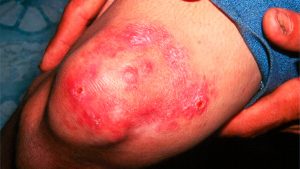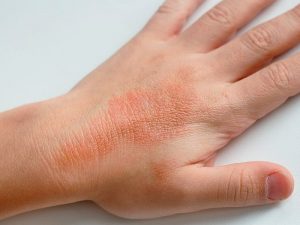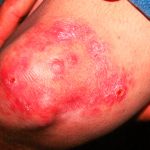Skin cancer – Every time you walk outside you are exposing your largest organ to the outdoor elements and, unprotected, you put yourself at risk of cancer? That’s right, your skin, or epidermis, is the largest and fastest-growing organ of the body. The skin’s jobs include protecting your internal organs, keeping out germs, and regulating body temperature.
Fast Facts about Skin
- There are about 19 million skin cells in every inch of the body.
- The body replaces 30,000 to 40,000 old skin cells a
- The top 18 to 23 layers of the skin are made up of dead cells.
The skin protects the body, so you must protect your skin, because just like your other organs, the epidermis is susceptible to life-threatening illnesses such as cancer. Skin cancer is the most common type of cancer. This illness is an abnormal growth of skin cells, and most commonly develops on the areas of the body with the most exposure to the sun. The four most common types of skin cancer are basal and squamous cell skin cancer, melanoma, and Merkel cell skin cancer, lymphoma of the skin and kaposi sarcoma. When diagnosed early, skin cancer is almost always treatable, so educate yourself on about the early signs of skin cancer in order to know what to look for and to know when to get checked. Prevention is the key. Applying sunscreen SPF 15 or higher can reduce the risk of developing squamous cell carcinoma by 40 per cent.
Skin Cancer Statistics
- More people are diagnosed with skin cancer each year in the United States than all other cancers combined.
- One in five Americans will develop skin cancer by the age of 70.
- Actinic keratosis is the most common pre-cancer, affecting more than 58 million Americans.
Skin Cancer Death Rates
- One person dies of melanoma every hour.
- Basal cell carcinoma is responsible for more than 3000 deaths in the US every
- More than 15,000 US patients die from squamous cell carcinoma every
Causes of Skin Cancer
Each form of skin cancer is unique, and so are the causes. One common denominator in cancer research is ultraviolet radiation (UV). The International Agency for Research on Cancer (affiliated with the World Health Organization) includes UV ray tanning devices on its Group 1 list for cancer-causing agents. More than 419,000 cases of skin cancer in the US yearly are linked to indoor tanning. While there can be other factors at play when it comes to developing skin cancer, such as genetics, it has been shown that more people develop skin cancer due to indoor tanning than those who develop lung cancer from smoking. UV rays don’t just come from indoor tanning. It is important to protect your skin with sunscreen SPF 15 or higher from natural UV rays that come from sun exposure. On average, risk for melanoma doubles if a person has had more than five sunburns.
Types of Skin Cancer
So what are the different types of skin cancer? Let’s begin with melanoma skin cancer versus non-melanoma skin cancer. Skin cancer begins inside the skin cells, but melanoma and non-melanoma cancers start out in different cells and thus are treated differently. Melanoma is a far more serious and damaging cancer. It begins in the melanocytes cells (the cells that produce melanin). Melanoma cells often still produce melanin even when infected, so melanoma tumors are usually black or brown. Non-melanoma skin cancers still begin in the skin cells, but not in the melanocytes, and behave differently. These cancers are less aggressive and rarely spread to other parts of the body, thus are easier to treat. So what does skin cancer look like? The skin cancer symptoms for each type of condition vary and so it’s important to know the early signs for each:
- Actinic keratoses: This condition displays early signs or precancerous growths and is common in people with fair skin who have experienced years of sun exposure. AK appears as dry or scaly patches, usually on the head, hands, neck or forearms. Since this is a precancerous condition, early diagnosis is key.
- Basal cell carcinoma: The most common skin cancer is basal cell carcinoma (BCC). An estimated 4.3 million cases of BCC are diagnosed in the US each year. Look for a flesh-colored, pearl-like bump or pinkish patch of skin. Failure to treat BCC early will result in invasion of surrounding tissue, nerves and bones, resulting in possible damage and disfigurement.
- Squamous cell carcinoma: The second most common form of skin cancer, with more than one million cases diagnosed in the US This cancer presents as a red firm bump, scaly patch or a sore that continuously heals and reopens. SCC can cause damage and disfigure by developing deep within the skin. Early diagnosis and treatment is the key.
- Melanoma: The deadliest skin cancer. Melanoma most commonly appears in the form of a new mole or dark spot. Early diagnosis of possible skin cancer moles is the key to getting ahead of melanoma. Only 20 to 30 per cent of melanomas are found in existing moles, while 70 to 80 per cent arise on apparently normal skin.
How to Treat Skin Cancer
There is no singular treatment for all skin cancers. If you are diagnosed with a skin cancer condition your doctor will need to determine the stage and severity. The most common treatments for non-melanoma and melanoma cancers are:
- Surgery: There are several surgical procedures that remove cancerous tumors, tissue and infected lymph nodes. The method will depend on the type, risk, location and size of the
- Radiation therapy: Radiation is beamed onto the affected area and nearby tissue. This treatment is usually performed on high-risk cancers when surgery is not an option.
- Drug therapy: Used for both melanoma and non- melanoma conditions. A cocktail of drugs is administered to prevent further cancer cell growth or to destroy them.
How to Prevent Skin Cancer
- Apply sunscreen: Regular daily use of SPF 15 or higher sunscreen reduces the risk of developing melanoma by 50 per cent.
- Sit in the shade: The sun is strongest between the hours of 10am and 2pm.
- Reapply sunscreen every two hours when outdoors, particularly after swimming or sweating.
- Avoid tanning beds.
- Perform regular self-exams: Be aware of the warning signs.











